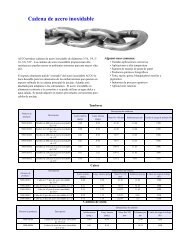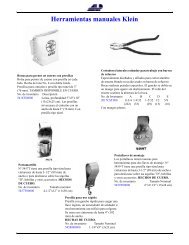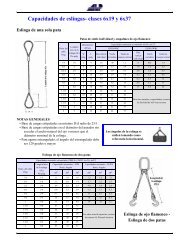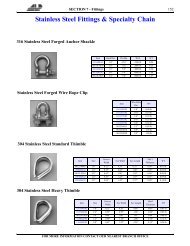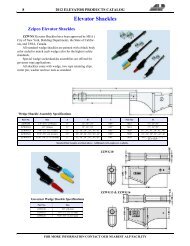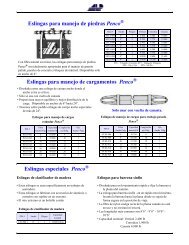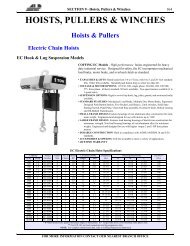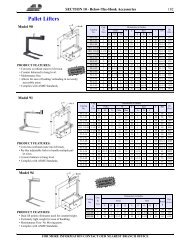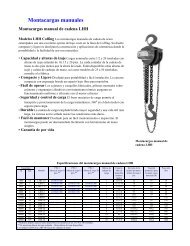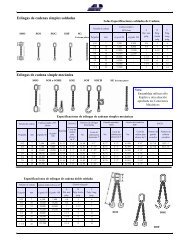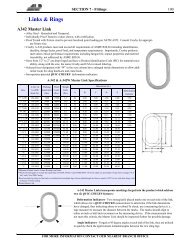General Products - ALP Industries Inc.
General Products - ALP Industries Inc.
General Products - ALP Industries Inc.
- No tags were found...
You also want an ePaper? Increase the reach of your titles
YUMPU automatically turns print PDFs into web optimized ePapers that Google loves.
SECTION 1 - Wire Rope 2In Lang Lay wire ropes the direction of the wires aretwisted in the same direction as the strands. Lang Lay maybe Right Lang Lay or Left Lang Lay depending upon thedirection of the strands. The wires of a regular wire ropeseem to travel parallel and along the length of the rope whilethose of a lang lay rope appear to travel around the rope.In addition, the Lay Length, the length of the rope necessaryfor one strand to travel completely around the rope (SeeFig.) may be varied slightly by manufacturer.Most wire rope has a Bright, self-colored finish and acoating of lubricant. However, many wire ropes are galvanized,stainless steel, or plastic/vinyl/urethane coated.Most wire ropes are supplied with either a fiber or steelcore. The core’s primary function is to support the wirestrands of the rope, maintaining the corrective relative positionsduring the operating life. Fiber Cores are composed ofnatural Vegetable Fiber Core (VFC - sisal, etc.) or SyntheticFiber Core (PFC- polypropylene, etc.) which havebeen formed into yarns and twisted into strands. Steel coresmay be Independent WireRope Core (IWRC) or WireStrand Core (WSC). Thesesteel cores provide more supportthan fiber cores to theouter strands during the rope’soperating life. Steel coresresist crushing, are more resistantto heat, reduce the amountof stretch, and increase thestrength of the rope. The Right WayUnreeling & UncoilingThe Right Way to Unreel. To unreel wire rope from aheavy reel, place a shaft through the center and jack up thereel far enough to clear the floor and revolve easily. Oneperson holds the end of the rope and walks a straight lineaway from the reel, taking the wire rope off the top of thereel. A second person regulates the speed of the turning reelby holding a wood block against the flange as a brake, takingcare to keep slack from developing on the reel, as this caneasily cause a kink in the rope. Lightweight reels can beproperly unreeled using a vertical shaft; the same careshould be taken to keep the rope taut.The Wrong Way to Unreel. If a reel of wire rope is laidon its flange with it’s axis vertical to the floor and the ropeunreeled by throwing off the turns, spirals will occur andkinks are likely to form in the rope. Wire rope alwaysshould be handled in a way that neither twists nor unlays it.If handled in a careless manner, reverse bends and kinks caneasily occur.The Right WayThe Right Way to Uncoil.There is only one way to uncoilwire rope. One person musthold the end of the rope while asecond person rolls the coilalong the floor, backing away.The rope is allowed to uncoilnaturally with the lay, withoutspiraling or twisting. Alwaysuncoil wire rope as shown.The Wrong Way to Uncoil. If a coil of wire rope is laid flaton the floor and uncoiled by pulling it straight off, spiralswill occur and kinking is likely. Torsions are put into therope by every loop that is pulled off, and the rope becomestwisted and unmanageable. Also, wire rope cannot beuncoiled like hemp rope. Pulling one end through the middleof the coil will only result in kinking.KinksGreat stress has been placed on the care that should betaken to avoid kinks in wire rope. Kinks are places wherethe rope has been unintentionally bent to a permanent set.This happens where loops are pulled through by tension onthe rope until the diameter of the loop is only a few inches.They are also caused by bending a rope around a sheave havingtoo severe a radius. Wires in the strands at the kink arepermanently damaged and will not give normal service,even after apparent “restraightening.”Drum Winding. When wire rope is wound onto a sheaveor drum, it should bend in the manner in which it was originallywound. This will avoid causing a reverse bend in therope. Always wind wire rope from the top of the one reelonto the top of the other. Also acceptable, but less so, is rereelingfrom the bottom of one reel to the bottom of another.Re-reeling may also be done with reels having their shaftsvertical, but extreme care must be taken to ensure that therope always remains taut. It should never be allowed to dropbelow the lower flange on the reel. A reel resting on thefloor with its axis horizontal may also be rolled along thefloor to unreel the rope.Wire rope should be attached at the correct location on aflat or smooth-faced drum, so that the rope will spool evenly,with the turns lying snugly against each other in even layers.If wire rope is wound on a smooth-face drum in the wrongdirection, the turns in the first layer of rope will tend tospread apart on the drum. This results in the second layer ofrope wedging between the open coils, crushing and flatteningthe rope as successive layers are spooled.FOR MORE INFORMATION CONTACT OUR NEAREST BRANCH OFFICE





